Enhancing hydropower generation Predictions: A comprehensive study of XGBoost and Support Vector Regression models with advanced optimization techniques
IF 6
2区 工程技术
Q1 ENGINEERING, MULTIDISCIPLINARY
引用次数: 0
Abstract
Hydropower plays a crucial role in electricity generation, contributing over 60% of total renewable energy output. Its ability to stabilize energy fluctuations makes it essential in green energy initiatives. Accurate prediction of hydropower production is vital, considering its dependence on various factors like weather, water storage, and electricity generation. Traditional methods struggle with the complexities involved. This study utilized Support Vector Regression (SVR) and eXtreme Gradient Boosting (XGBoost) algorithms, both individually and in hybrid models enhanced by optimization techniques like Slime Mould Algorithm (SMA), Aquila Optimizer (AO), and Grey Wolf Optimization (GWO). XGBoost outperformed SVR in single model predictions with an R2 value of 0.8632 and RMSE of 40.90, and when optimized, the hybrid XGBoost models showed superior performance, with XGBoost-SMA achieving the highest accuracy. The results revealed that the XGBoost-SMA model achieved the most desired accuracy with an R2 value of 0.9713 and a root mean square error of 18.73 for the test dataset. This research highlights machine learning’s applicability in hydropower prediction and suggests hybrid models as a promising approach for better accuracy, emphasizing XGBoost’s potential in efficient hydropower forecasting to meet global electricity demands.
求助全文
约1分钟内获得全文
求助全文
来源期刊

Ain Shams Engineering Journal
Engineering-General Engineering
CiteScore
10.80
自引率
13.30%
发文量
441
审稿时长
49 weeks
期刊介绍:
in Shams Engineering Journal is an international journal devoted to publication of peer reviewed original high-quality research papers and review papers in both traditional topics and those of emerging science and technology. Areas of both theoretical and fundamental interest as well as those concerning industrial applications, emerging instrumental techniques and those which have some practical application to an aspect of human endeavor, such as the preservation of the environment, health, waste disposal are welcome. The overall focus is on original and rigorous scientific research results which have generic significance.
Ain Shams Engineering Journal focuses upon aspects of mechanical engineering, electrical engineering, civil engineering, chemical engineering, petroleum engineering, environmental engineering, architectural and urban planning engineering. Papers in which knowledge from other disciplines is integrated with engineering are especially welcome like nanotechnology, material sciences, and computational methods as well as applied basic sciences: engineering mathematics, physics and chemistry.
 求助内容:
求助内容: 应助结果提醒方式:
应助结果提醒方式:


